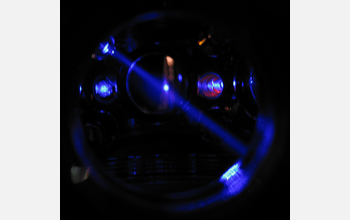Multimedia Gallery
Strontium Optical Atomic Clock
JILA's strontium optical atomic clock is now the world's most accurate clock based on neutral atoms. Shining a blue laser onto ultracold strontium atoms in an optical trap tests how efficiently a previous burst of light from a red laser has boosted the atoms to an excited state. Only those atoms that remain in the lower energy state respond to the blue laser, causing the fluorescence seen here.
This research is partially supported by the National Science Foundation through the Atomic, Molecular and Optical Physics Frontier Center at JILA. To learn more about the world's most accurate clock, see the NSF Discovery story "Coping With Unusual Atomic Collisions Makes an Atomic Clock More Accurate." (Date of Image: 2008)
Credit: Sebastian Blatt, JILA, University of Colorado
Images and other media in the National Science Foundation Multimedia Gallery are available for use in print and electronic material by NSF employees, members of the media, university staff, teachers and the general public. All media in the gallery are intended for personal, educational and nonprofit/non-commercial use only.
Images credited to the National Science Foundation, a federal agency, are in the public domain. The images were created by employees of the United States Government as part of their official duties or prepared by contractors as "works for hire" for NSF. You may freely use NSF-credited images and, at your discretion, credit NSF with a "Courtesy: National Science Foundation" notation.
Additional information about general usage can be found in Conditions.
Also Available:
Download the high-resolution JPG version of the image. (1.1 MB)
Use your mouse to right-click (Mac users may need to Ctrl-click) the link above and choose the option that will save the file or target to your computer.

